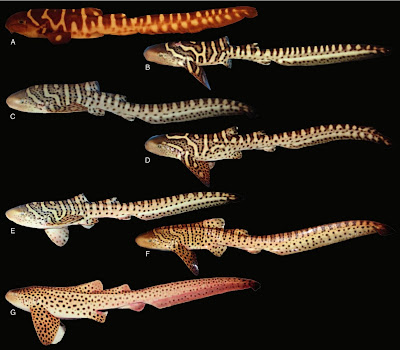 |
| Stegostoma tigrinum Forster, 1781
in Dahl, Sigsgaard, Mwangi, et al., 2019.
DOI: 10.1643/CG-18-115
|
Abstract
The Zebra Shark, in recent years known as Stegostoma fasciatum (Hermann, 1783), is well known for its dramatic ontogenetic change of color pattern, from striped (“zebra”) juveniles to spotted (“leopard”) adults. Nevertheless, many aspects of the species' biology, ecology, and morphology are still unknown or inadequately described, and its nomenclature is contentious. This study introduces a hitherto undescribed color morph of the Zebra Shark and provides an updated diagnosis and redescription of the species. Firstly, we establish that the Zebra Shark remains a single species based on genetic data from mitochondrial COI and ND4 markers. Secondly, through morphological analyses, we conclude that there are two morphs of the species, the known, zebra striped morph and a new, sandy colored morph. Both morphs were studied morphometrically to expose any ontogenetic changes, such as a decrease in the relative length of the tail with increasing total length (TL). The external coloration pattern clearly differentiates the two morphs, and both morphs can be further divided into three stages based on color pattern and size: juveniles (255–562 mm TL), transitionals (562–1395 mm TL), and adults (>1300 mm TL). The transitional sandy morph is dorsally covered by a swirly pattern of thin, dark brown bands edged with freckle-like brown spots. The adults are a uniform sandy beige, partially covered with brown freckles. A mature male of the zebra morph displayed a yet unknown feature of the claspers: a small, triangular spike extruding from the dorsal terminal of the clasper glands. Finally, we reviewed the nomenclature of the species and suggest that the original name Stegostoma tigrinum Forster, 1781 should be used as the senior synonym for the species.
Stegostoma Müller and Henle, 1837
Squalus Seba, 1759; Forster, 1781; Hermann, 1783; Bloch, 1784; Broussonet, 1784; Bonnaterre, 1788; Gmelin, 1789; Pennant, 1791; Shaw, 1804; Bleeker, 1852; Gronow, 1854.
Scyllia van Hasselt, 1823.
Scyllium Rüppel, 1837.
Stegostoma Müller and Henle, 1837; Blyth, 1847; Günther, 1870; Garman, 1913; Whitley, 1939; Bass et al., 1975; Dingerkus, 1986; Compagno, 2001; Goto, 2001; Weigmann, 2016.
Stegostonea Regan, 1929: 293, possible error for Stegostoma Müller and Henle, 1837.
Stegastoma Herre, 1934: 10, possible error for Stegostoma Müller and Henle, 1837.
Stegastoma Last and Stevens, 1994: 138 apparent error for Stegostoma Müller and Henle, 1837.
Type species.— Squalus fasciatus Bloch and Schneider, 1801, by original designation, equals Squalus fasciatus Hermann, 1783.
 |
| Fig. 5: The three ontogenetic stages of the external morphology of the zebra morph of Stegostoma tigrinum: juvenile (A), transitional (B–F), and adult (G). |
Stegostoma tigrinum
Zebra Shark
Diagnosis: Stegostoma tigrinum is characterized by a long caudal fin (49.9–54.2% TL) and five dorsolateral ridges along the body, visible even in hatchlings. Spiracles bean shaped, large (length 0.4–1.7% TL); eyes small (length 0.9–2.1% TL); barbels two, short (0.6–2.8% TL); gill slits five, but fourth and fifth partly fused so only four noticeable from a distance; pectoral fins large (anterior margin length 10.4–19.1% TL), broad and rounded; first dorsal fin originates far posteriorly above pelvic fins. Two color morphs, with a three-stage ontogenetic color and pattern change. Zebra morph: juveniles with dark brown background and cream colored bands (zebra-like); transitionals light brown with dark bands, broken up by dots; adults beige to yellow with spotted pattern (can be leopard-like). Sandy color morph: transitionals light beige background with swirly pattern of narrow, darker brown bands with tiny spots breaking up the pattern; adults uniformly sandy beige with tiny dark brown freckles. Maximum length 2050 mm TL, hatchlings approx. 250 mm TL; pectoral-fin rays of semi-plesodic structure, reaching approx. 66–88% of pectoral fin. Total vertebrae 207–262, monospondylous precaudal vertebrae 43–49, diplospondylous precaudal vertebrae 38–50, diplospondylous caudal vertebrae 120–175, precaudal vertebrae 81–101. Tooth rows upper jaw: 13–30, lower jaw: 22–30, and series count, upper jaw: 7–27, lower jaw: 8–16. Ring-type intestine with 18–20 valvular turns.
...
Distribution: The sandy color morph of S. tigrinum has in the present study been documented from a single location, off the coast of Kenya, ca. 10 km north of Malindi (Fig. 9). Six specimens of this morph were caught in June 2016 (rainy season) at a depth of 12 m, on a sandy substrate. A seventh specimen was caught in May 2017, 15 km north of Malindi on sandy bottom, also at 12 m depth.
Etymology: The name Stegostoma tigrinum is made up of the Greek stego meaning cover, and stoma meaning mouth, and can thus be translated to ‘covered mouth' (Froese and Pauly, 2018). The epithet tigrinum refers to the juveniles’ banded pattern.
Rikke Beckmann Dahl, Eva Egelyng Sigsgaard, Gorret Mwangi, Philip Francis Thomsen, René Dalsgaard Jørgensen, Felipe de Oliveira Torquato, Lars Olsen and Peter Rask Møller. 2019. The Sandy Zebra Shark: A New Color Morph of the Zebra Shark Stegostoma tigrinum, with A Redescription of the Species and A Revision of Its Nomenclature. Copeia. 107(3); 524-541. DOI: 10.1643/CG-18-115



